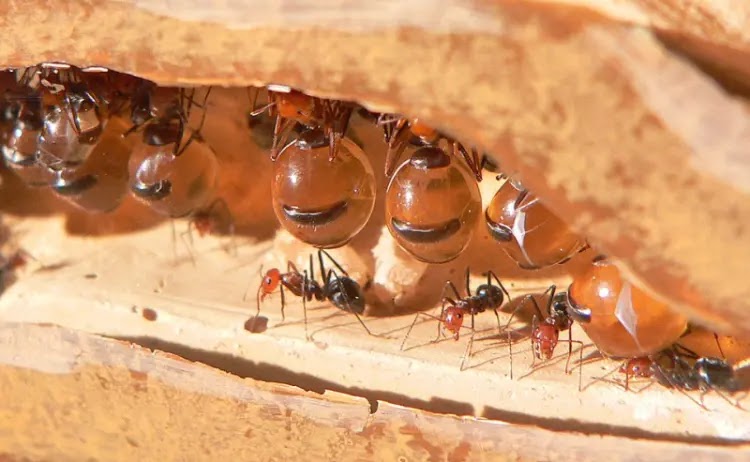Information
Honeypot Ants - Honey Collectors For The Ant Colony
We commonly receive our source of honey from the bees in their nest. However, most people might not know that bees are not the only creature that collects honey from nectars as there are various others that are capable of doing so.
It is known as honeypots or honey ants as they are specific workers from ant species that have the sole job of eating nectars until they themselves become the live storage of honey. The honeypot ants comprise from some species of ants but the most common one will be Camponotus inflatus.
All honeypot ants will act as live storage of honey when their colony is lacking in food. The discovery of such a unique capability was first documented in 1881 by Henry C. McCook and was then further explained in 1908 by William Morton Wheeler.
ADVERT
Becoming The Source Of Food For The Colony
All ant workers will eat all the nectars that have been gathered from various plants until their stomach expands to the extent that they looked as if they are about to explode and burst out all of the honey inside of them.
Known as honey ants, the sweet fluid will be regurgitated by honeypot ants each time one of their colony members required food in the most desperate times. The ants in the colony extract nutrients from them through the process known as trophallaxis.
Most of the honeypot ant species are found in dry areas, desert or semi-arid in Australia, the United States, Mexico, and the African continent where food sources are very scarce. Therefore, the production and storage of honey were believed to be their adaptation to surviving the harsh environment.
All honeypots are crucial resources to the colony in that some colonies are willing to attack and steal them. In Australia, the indigenous people also appreciate these honey insects and will try to find them.
All honey is unique as the ants used their own body to store them. When this sweet fluid inside the honeypot is needed, the ant workers will stroke the antenna of the honeypots causing the honeypot ants to regurgitate the fluid kept in their stomachs.
Comparison With Bee's Honey
In the documentary, Trials of Life 1990, David Attenborough was filmed putting a honeypot ant inside his mouth. The video above will show a short clip of David having a taste for himself, the sweet honey from this ant.
So the main question will be what are the comparison between the honey from this ant and the one coming from bees?
According to some research, despite both of them looking similar at first glance, the honey from honeypot ants has less consistency compared to bee's honey. It is still sweet but not as sweet as what we would have expected from bee's honey and it also has a bit of a sour taste to it.
Another distinct difference between the two types of honey will be the present glucose that comes in higher quantity compared to the fructose of honeypot ants whereas this is the other way around for bee's honey.
Both these honey however still contain high antioxidants in them.
ADVERT
Its Importance To The Australian Indigenous
Honeypot ants like Melophorus bagoti and Camponotus spp. are insects that can be consumed and have become part of the diet of the Australian Indigenous. These people will grind the surfaces to find the vertical tunnels of these ants.
They will then dig 2 meters deep to find these honeypot ants. Papunya, the northern part of Australia was named based on a story of honeypot ants or as they call it Dreaming which are owned by the natives there such as Warlpiri.
Honeypot ants were recognized from the works of the Honey Ant Dreaming which was a mural that was painted in 1971 by the Western Desert Art Movement.
Source:










Post a Comment
0 Comments